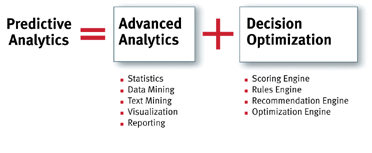How Does Predictive Analytics Work?
To direct, optimize, and automate decisions to improve business processes, the Predictive Enterprise employs predictive analytics. Predictive analytics includes both:
- Analysis of past, present, and projected future outcomes using advanced analytics
- Decision optimization for determining which actions will drive the optimal outcomes, and then delivering those recommended actions to the systems or people that can effectively implement them

Figure 1. Predictive analytics includes both advanced analytics and decision optimization
Advanced analytics are used to examine the way in which specific business issues relate to data on past, present, and projected future actions. Advanced analytics include statistical, mathematical, and other algorithmic techniques such as those in the diagram above, and are more complex than the basic analytics used to compute frequencies, cross-tabs, and query and reporting cubes.
From this advanced analysis results insight that is used to determine which actions will drive the optimal outcomes. Recommended actions, along with supporting information, are delivered to the systems or people that can effectively implement them. For a detailed view of predictive analytics at work, please see the diagram below.
Figure 2. How predictive analytics works
Through measuring uncertainty surrounding these issues, predictive analytics enables proactive risk management, serving as a guide for refining key decision making processes through controlled, iterative testing of potential actions and their likely intended—and unintended—consequences. By deploying predictive analytics within front-line operational systems, specific organization goals relating to revenue increases, cost reductions, process improvements, and competitive advantages can be achieved.
Although the processes surrounding predictive analytics are complicated, implementing an SPSS predictive analytics solution is not. We’ve built 37 years of analytical experience into our software, resulting in products that make these sophisticated, complex processes easy to implement.